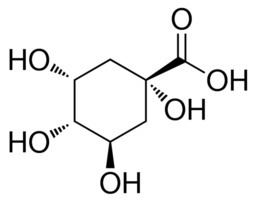Formula C7H12O6 Density 1.35 g/cm³ | Molar mass 192.17 g/mol | |
 | ||
Quinic acid meaning
Quinic acid is a cyclitol, a cyclic polyol, and a cyclohexanecarboxylic acid. It is a crystalline acid obtained from cinchona bark, coffee beans, and other plant products and made synthetically by hydrolysis of chlorogenic acid. Quinic acid is also implicated in the perceived acidity of coffee. It is a constituent of the tara tannins.
Contents
- Quinic acid meaning
- Medical vocabulary what does quinic acid mean
- History
- Characteristics
- Industrial applications
- Pharmaceutical uses
- References

Medical vocabulary what does quinic acid mean
History

This substance was isolated for the first time in 1806 by French pharmacist Nicolas Vauquelin and further reactions from this acid to synthesize other compounds were studied by German chemist Eduard Lautemann in 1863.
Characteristics
It is soluble in water and crystallizes in large colorless prisms.
Industrial applications
Quinic acid is used as an astringent. It can be found in the bark of Eucalyptus globulus.
Pharmaceutical uses

This acid is a versatile chiral starting material for the synthesis of new pharmaceuticals. A medication for the treatment of influenza A and B strains called Tamiflu has been successfully developed and launched into the market.

Quinic acid is also thought to displace binding of the mu opioid receptor antagonist Naltrexone, even though this acid was originally thought to be pharmacologically inactive.


